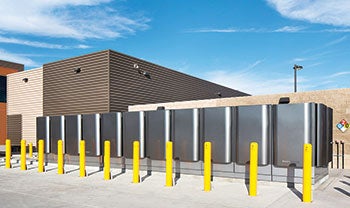Hospital turns to clean, cost-effective energy source
 |
| PHOTO BY BERNARD ANDRE PHOTOGRAPHY Sutter Health’s Sutter Santa Rosa Regional Hospital’s on-site compact fuel cell unit generates up to 70 percent of the hospital’s electric power. |
Although Sutter Health’s Sutter Santa Rosa (Calif.) Regional Hospital, which opened in October 2014, incorporates many sustainable design elements, an on-site fuel cell system that cleanly generates a large percentage of the facility’s electric power was the deciding factor in the system’s decision to pursue Leadership in Energy and Environmental Design Gold rather than Silver certification for the hospital, says Sutter Health’s program manager, Tom Minard.
Developed by Bloom Energy, Sunnyvale, Calif., the proprietary solid-oxide fuel cell technology uses an electrochemical process to turn natural gas and air into electric power without using combustion. Fuel cells, which health care facilities in the United States are just beginning to use as a power source, emit much lower levels of carbon dioxide than do coal-fueled electric power plants. Sutter Health selected the Bloom system because it doesn’t generate waste heat, as some other models do, Minard says.
Occupying roughly the size of two parking spaces in a Sutter Santa Rosa parking lot, the unit is sized to generate 375 kilowatts of power continuously. Although it is considered a supplemental rather than the primary power source, the system provides up to 70 percent of the $284 million hospital’s electricity, with the remaining needed electrical power delivered via the standard electric grid.
“Due to California Office of Statewide Health Planning and Development regulations, we can’t use the fuel cell system as our main source of power,” Minard explains. “We have to be hooked up to the grid. But when our fuel cell is running, we take much less power from the grid.” Like other hospitals, Sutter Santa Rosa has diesel-powered generators for backup in the event of power outages.
In a region where natural gas is much more affordable than electric power, fuel cell technology offers economic as well as environmental benefits, points out the project’s lead architect Greg Osecheck, AIA, associate vice president of HGA Architects and Engineers in Roseville, Calif.
Pacific Gas & Electric Co., which supplies natural gas and grid electricity to the hospital, offered Sutter Health a financial incentive to adopt the fuel cell technology. Even though the health system purchased the unit and a 10-year maintenance contract from Bloom for several million dollars, the technology is expected to pay for itself in six years. “For a hospital that’s going to last 50 years, that’s a good return on investment,” Osecheck says.
Each fuel cell “energy server,” as Bloom describes the units, consists of thousands of stacked 4-inch flat ceramic disks. “They resemble the old floppy disks we used to use with personal computers,” Minard notes.
Minard also says that the hospital hasn’t incurred any operational burdens because of the technology. Bloom monitors the equipment via the Internet, does preventive maintenance and makes any repairs.




